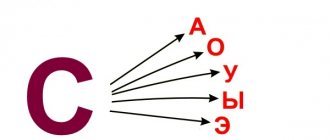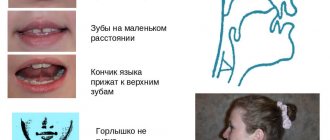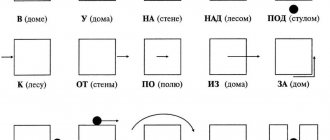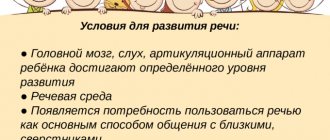Age of the child and readiness of the speech apparatus
If a 3-4 year old child does not pronounce the sound and the letter CH, this is still within the normal range, since the articulation of the sound [CH] is complex:
- the tip of the tongue rises to the palate, bending like a hook so as to touch the alveoli of the upper teeth from the inside;
- for a short moment it sticks to the roof of your mouth;
- then the entire body of the tongue sharply falls down.
Such complex articulation of the sound [H] is available to children from 5 years old. The child is ready to pronounce it if he has already mastered the sounds [ZH], [SH] and [SH].
Listen to the sound formation [H] and you will hear that the sound consists of soft [t'] and sharp [uh'].
Sound characteristics [H]:
The sound [CH'] is consonant, dull, always soft.
Corrective and developmental tasks.Teach the child to listen carefully to the speech of an adult, to correct mistakes in the incorrect use of gender endings of adjectives.
Teach auditory-pronunciation discrimination of sounds [Ш] - [С].
Improve the skills of analytical and synthetic activities.
Continue to learn how to compose sentences based on supporting words and analyze these sentences.
Task 1. Didactic exercise “Correct mistakes.” The adult reads the sentences to the child, and the child listens carefully, corrects the mistakes made and pronounces the correct version.
Beautiful pen. High house. Bad weather. Strong wind. Big puddle. Chicken egg. Angry dog. Railway. Beautiful cat.
Task 2. Differentiation of sounds [Ш] - [С]. The adult invites the child to look at a number of pictures, name the odd one and explain his choice (the adult does not name the pictures):
pike, brush, sorrel, herring.
Task 3. Compare the articulation of the sounds [Ш] and [С] (find the commonality and difference), remember the characteristics of the sounds [Ш] and [С], designation.
Didactic exercise “Clap your hands if you hear the sound [Ш]”:
s, sch, sch, s..,; Xia, sha, schu, si...; ashch, as, axis, oshch...; pike, Sima, goose, bream, autumn, box...
Didactic exercise “Say the opposite”:
scha-sya, schu-...; oh-oh, oh-oh...
Repeat the syllable sequence after the adult:
bye-bye, bye-bye, bye-bye, bye-bye, bye-bye, bye-bye, bye-bye.
Finish the word with the desired sound [Ш] - [С]:
le..., gu..., pla...
Name the extra word in the series (based on the presence of sounds [Ш] and [С] in the words):
thickets, puppy, autumn,
horsetail;
aspen, sow, apiary, vegetables.
Task 4. Arrange the pictures into two piles: objects whose names contain the sound [Ш], and objects whose names contain the sound [С]; divide these words into syllables, come up with a sentence with each word.
The adult names the word as a whole, and the child names it by sounds, determines the number of sounds and syllables, the place of sounds [С] and [Ш] in words:
Sima, pike, horsetail, goose.
Task 5. Name as many words as possible with the sounds [Ш] and [С]. Remember riddles, pure sayings with the sounds [Ш] and [С] (see topics No. 25,37).
Make sentences from the words, name familiar prepositions:
Sima, yes, cabbage soup. Ooh, pike, Senya. Senya, pike, catch.
Senya, put, box, vegetables, in.
Analysis of proposals, drawing up proposal diagrams.
Task 6. Remember the letters that represent the sounds [Ш] and [С] in writing.
Recording sentences from dictation in block letters, reading:
Sima has a pike.
Sound setting [h]
The articulation of the sound [H] can be set in 3 ways:
- Using part [t']: pronounce this sound at a very fast pace so that the tip of the tongue reaches the base of the upper incisors from the side of the palate. Then begin to wrap it, as if stroking the tubercle at the roots of the teeth - the alveoli. And at the same time you need to stretch the corners of your mouth wide, as if in a smile.
- Using two components [t'] and [sch']: smiling widely, first slowly, and then faster and faster, pronounce alternately [t'] and [sch']. Speed allows them to merge and achieve clear articulation of sound.
- Explain sound formation by breaking down the process into stages: for the exercise you need a piece of paper or a chocolate bar. It rests on the tip of the tongue and the child is asked to stick it over the hole, which is located between the upper incisors on the inside. To do this, you must first feel this place, and then send your tongue on a “task” with a piece of treat. To fix chocolate or paper, you need to apply force, which will serve as articulatory gymnastics and allow you to automate the movement of the tongue.
In all cases, it is necessary to sit the child in front of a mirror and focus on ensuring that he follows his movements in the reflection. Some parents ignore this rule, but speech therapy sessions are much more productive with visual control of the positions of the mouth and tongue.
Work on the sounds of Ts. Ch. Shch. (Staging, consolidation, pronunciation)
B. Setting the sound c.
In the simplest cases, the sound ц can be produced through imitation.” With the mouth slightly opened, the teacher places the tip of the tongue behind the lower incisors and presses the front part of the back to the alveoli of the upper incisors. Following this, the teacher pronounces ts, highlighting the fricative moment. The student, imitating the teacher, also tries to pronounce ts.
If a student has a tendency to replace q with the sound s (absence of a closing moment), you can point out to him that q = ts, but that in this case t is pronounced with the tip behind the lower teeth and after the explosion the tongue does not jump back, but remains in the same place, at the teeth. When a separate ts is obtained, you can move on to the reverse syllable (ats), then after a while to the pronunciation of ts (between vowels (atsa) and, finally, to the direct syllable (tsa). At first, the teacher invariably uses the movements of his hand (conducting) to controlling the student's articulation.
During the first exercises, you need to require a somewhat exaggerated pronunciation of the sound, with a clear highlight of both its moments. Allowing some delay at the CONCLUSIVE moment (shutter for t) and fricative (constriction for c), you need to ensure that the transition from the first to the second is instantaneous.
In difficult cases, if the student cannot in any way grasp the nature of the articulation of the continuous, it is useful to give the deaf-mute an idea of the method of its formation, first on the auxiliary bilabial affricate, as it is more accessible to observation. For this purpose, you should close your lips tightly, and then blow up the lip seal with air pressure and switch to blowing (Fig. 96), which results in a sound similar to pf - with a bilabial f. After this, you should take the student’s hand in your own and conduct at the same time as you pronounce the sound. In this case, before the explosion the hand is held motionless, at the moment of it it is sharply directed downwards, and when transitioning to the sound f (bilabial) it continues its movement smoothly.
Following this, the student can be shown that the lips cannot be opened before moving the hand. Having thus taught the student to “obey the hand,” one should again and again fix his attention on the constituent moments of the sound and, regulating the articulation with the movement of the hand, maintain each of these moments for 1-3 seconds.
After this, you can take a reverse syllable with the vowel a. Now a new movement of the hand should be added: when a, the hand rises up, when closing the lips, it freezes motionless, and then - as in the previous exercise.
When the student is accustomed to the rapid transition from stop to constriction, from plosive to fricative, formed in the same place, you can begin to set the c.
At first, we can recommend pronouncing c while maintaining a small gap between the incisors (the work of the tongue is better visible), but as soon as it turns out to be possible, you should move on to the normal setting (see above). At first, children should be required to pronounce the sound in a somewhat exaggerated manner.
B. Disadvantages of pronunciation of the sound ts.
1. The tip of the tongue forms a bow at the upper alveoli, then descends to the lower incisors for s; there is an unnecessary movement that interferes with the close adhesion of yew, as a result of which deaf and dumb people often get q = thousand, which greatly distorts speech; this defect occurs in cases where the teacher only shows students that q is equal to mc; they read this combination the way they are used to pronouncing individual sounds;
It is necessary from the very beginning of the production of this sound, before the students have time to pronounce it, to warn the children that here t is pronounced differently; precisely, clearly shown to them, with their mouth slightly open, the special articulation of this t; force them, with the help of their little finger or probe (Fig. 97), to hold the tailbone of the tongue down and quickly connect the explosion with the sound s, which is pronounced at first longer than usual; At the same time, it is also necessary to draw the children’s attention to the fact that with this double articulation the lower jaw does not withdraw. A longer pronunciation of s does not pose a danger to the correctness of the sound in the future if the teacher systematically brings the duration to the norm with appropriate exercises; Write next to each other the correct and incorrect pronunciation, crossing out the incorrect ones.
2. Instead of ts, the related t is pronounced (Fig. 67); the difference between these sounds is not always immediately perceived by the ear, but with prolonged pronunciation ts and t it is indicated quite clearly;
show in front of the mirror that with c the teeth are clenched, while with t there is a gap between them, 2 mm wide or more;
force the child to pronounce sts (sts), and the moment of whistling is extended
s___________ ts________ thanks to this approach the language}' is easier
get into the proper articulatory position; it is necessary to use the sense of touch of the exhaled stream and explosion; Write the letters c and t next to each other and differentiate the sounds.
A. Normal installation.
The lips are pushed forward a little less than with w.
The corners of the mouth are close.
The incisors are exposed and compressed.
Language. “Upper” and “lower” articulation options are possible.-
a) At upper h:
the tip and entire anterior edge of the tongue is pressed against the alveoli or immediately behind. alveoli to the sky; the lateral edges are adjacent to the upper molars; the middle back of the tongue approaches the palate;
the tip of the tongue “bounces” to a position corresponding to the upper w, the soft shade of which is determined by the higher and more forward position of the tongue.
b) At lower h:
1) the tip and the entire anterior edge of the tongue rests on the alveoli of the lower incisors; the back closes with the alveoli of the upper incisors or immediately behind them with the hard palate; lateral edges - as with the upper part;
2) the back “bounces” to a position corresponding to the lower w, the soft shade of which is determined by the raised back and the more forward position of the tongue.
The soft palate is raised.
The vocal cords are spread apart.
7. Air voltage is strong.
8. A deaf-mute person sees clenched teeth or a small gap between the upper and lower rows of teeth, protruding lips. If you open your mouth slightly, you can see the position and work of your tongue.
9. A deaf-mute person feels a push of warm air on the back of his hand.
B. Productions of the lower part.
If the student is assigned the sound ts, and he pronounces it confidently enough, you can use your finger, spatula or probe (Fig. 97) to slightly push the tip of the tongue back, which should result in an h. You don’t need to move the tip of the tongue down too much; because otherwise the front part of the back of the tongue will move too far back, and the result will not be h, but ksh.
In order for the ch to be sufficiently sonorous, it is necessary to extend the lips, which is easily achieved by pressing from the sides with the thumb and forefinger on the student’s cheeks. However, care should be taken for labialization only when correct articulation of the tongue has been achieved, since for the formation of h the position of the lips is still of secondary importance.
If c has not yet been delivered, the sound ch can be made, from th, also using a probe.
It is necessary to show the student, with his mouth slightly open, the position of the tip of the tongue and the nature of the work of the back of the tongue. It must be shown that the back should not pull away from the alveoli too far, as happens with simple t, but should only quickly move from the connection with the alveoli to the formation of a narrow gap at the site of this connection.
After the student is able to correctly reproduce the required operation of the tongue, the sound h can be obtained mechanically, as described above (by setting h FROM ts). In difficult cases, if it is difficult to master the merged pronunciation of a sound,
the auxiliary affricate described above.
Setting the upper part
The upper ch should also be placed from ь, since this teaches the deaf-mute to arch the back of his tongue, which is necessary to obtain a soft shade of sound, characteristic of Russian ch.
The only difference in the placement of the lower and upper h is that in the latter case the tip of the tongue does not simply move away, but at the same time rises to the alveoli, and this can be done either with the help of a probe, placing it this time under the tongue, or without the help of mechanical means by showing the student the articulation of sound with his mouth open.
The order of practicing the sound h is the same as for ts: first of all, a separate sound is taken, then the reverse syllable, etc. (see above).
When working on the sound h, you should use the hand movements that were recommended when setting c.
(farts ts and ch should be pronounced exaggeratedly by children at first, with a slight delay at the plosive and fricative moments. Only after long exercises can you demand a short pronunciation of these sounds, without fear that the children will pronounce them incorrectly. Only a few children are able to immediately pronounce short ts and h is correct. Of course, those who are given this should not be artificially delayed in slow pronunciation.
B. Disadvantages of pronunciation of the sound h.
The lips do not move forward, as a result of which there is a lack of hissing coloring of the sound h and a tendency to replace it with the sound t;
in front of the mirror, do exercises in pushing out the lips, as in w, or press on both sides of the cheeks so that the lips protrude.
2. With the upper h, there is often a lack of softening (not tyii, but tsh, like the Belarusian pronunciation of h); in this case, the deaf-mute articulates with the tip of the tongue at the alveoli, then pulls the tip of the tongue back and position w, leaving it raised; during the transition of the tip of the tongue from one position to another, very often a deaf-mute inserts the sound y, so that instead of h, the result is tysh (often with the withdrawal of the jaw);
show in front of the mirror that the jaw does not withdraw and that the teeth are clenched; let your hands (in the area of the hyoid bone) touch the movement of the tongue and exhalation during correct and incorrect pronunciation; On the chalkboard write tyiy and tysh next to each other and cross out the last one.
3. At the upper h, there is still an absence of hissing, so that instead of tyi, only the first component is heard - t (instead of boy - baby, instead of tea - tay); you get this defect” in those cases when the teacher from the very beginning allows a short, abrupt pronunciation of h instead of initially withstanding the long pronunciation of the second component - sh; it must be said that this defect is very common in schools for the deaf and dumb;
on the back of the hand, allow the student to feel the exhalation, exaggerating the strength and duration. With the lower h, it happens that the tongue is pulled too far to the border on the palate where t passes to k, and therefore instead of ts, ksh comes out;
opening your mouth slightly, show the child that the tongue articulates closer to the alveoli; or, starting from t, put h again by pressing on the tip of the tongue.
sch
A. Normal installation.
As indicated in the preliminary remarks, the Moscow and Leningrad pronunciations of the sound sch differ. However, both of them consist of elements that make up the sound h. For the Moscow sch the elongated 2nd moment of the sound h is used, and for Leningrad - both the 1st and 2nd (in combination: 2nd moment - 1st moment + 2nd moment, i.e. sh+t + sh Like the sound h, sh can be upper and lower. Thus, the need for a detailed description of the articulation of sh will be written off. We will only point out that when pronouncing sh, a deaf-mute sees protruded lips, bare clenched lips or close teeth. He feels (with the Leningrad version) first a warm current of air, then a push (explosion), and then again a warm exhalation; with the Moscow version - just a warm, drawn-out exhalation
B. Setting the sound
If you have a good h, setting up sh does not cause any particular difficulties. With a lower h, the lower u also shifts; with an upper h, the upper one shifts. The teacher invites the deaf-mute to pronounce the sound h, highlighting
its fricative moment. The long pronunciation of this fricative component h is sch. In its Moscow pronunciation (ш-шш.) The Leningrad version of the sound Ш is obtained by attaching the fricative component to the ch (sch-shch). If the student has both upper or both lower ch and sh, then it is even easier to make the Leningrad version of the sound ш by adding a simple sh to the ch.
B. Disadvantages of pronunciation of the sound sch.
1. What is the pronunciation of h, the same will be the pronunciation of sch; therefore, for all defects sch, you need to look for the cause in h and apply the correction methods indicated in the previous section.
2. Where the Moscow shch (sch - sh'sh) is used, we often hear a simple hard elongated sh;
show in front of the mirror that the tongue is closer to the alveoli (for the upper head) or closer to the lower incisors (for the lower head); between
| Summary | table of articulation settings for | sounds ts, ch, shch. | |
| At c | At h | When | |
| Lips | as with close to the teeth | pushed forward, slightly less than | as in h |
| Corners of the mouth | pulled back | at w they are brought together, compressed | Same |
| as with | |||
| Incisors | visible, compressed | Same | Same |
| Language | 1st moment: the tip rests on the teeth, as with c; the back is arched, touching the alveoli 2nd moment: tip in the same position; the back after the explosion rebounds to position c, leaving a NARROW channel in c in the middle | 1st option, upper part. 1st moment: the tip is pressed against the palate behind the alveoli; the lateral edges are pressed against the molars, the back is close to the palate; 2nd moment: the tip bounces to the position of the upper w, but the back is raised higher and moved forward, where its softness comes from 2nd option (lower part), 1st moment: the tip is at the alveoli of the lower incisors, the back closes with the palate behind the alveoli, the lateral edges are pressed against the upper molars; 2nd moment: the backrest rebounds to the lower position, but at a position closer to the incisors, | 1st option (upper Шch) 1st moment - see 2nd moment of sound h; The 2nd and 3rd moments are the same as the 1st and 2nd moments at h 2nd option (lower Shch), 1st moment - see 2nd moment of the lower h; 2nd and 3rd moments are the same as 1st and 2nd moments in Moscow pronunciation both upper and lower u = long 2nd moment of upper or lower h |
| where does his softness come from? | |||
| Soft sky | raised | raised | raised |
| Vocal cords | spread apart | spread apart | spread apart |
| Exhaled air tension | moderate | moderate | stronger |
| At c | At h | When | |
| The deaf-mute sees | clenched incisors or a small gap between the upper and lower rows of incisors | the same with slightly protruded lips | Same |
| The deaf-mute touches | explosion and the following cold stream of exhalation | Same | under Leningrad variant: first a warm exhalation, then an explosion followed by a warm exhalation; in Moscow pronunciation: long warm exhalation |
Using the chin and larynx, allow the student to feel the tense and raised state of the middle and root of the tongue.
3. If, during the exercises of the Leningrad version of sch, the child misses the first first (sh), so that it turns out h, then he should be forced to pronounce tyiyipshpysh (i.e. h h)
several times continuously with a significant lengthening of the moment, letting you feel a long exhalation with one hand, and with the other - the tension of the middle and root part of the tongue; this achieves a clear kinesthetic feeling of the tension of the tongue and exhalation when sewing, so that after my child it is no longer difficult to begin with the sound sew, adding h to it; during strenuous exercises, control is necessary and
eye (mirror), and hand.
D. Exercises on the sound u and on differentiation of sounds
| Defects | |||||
| Sounds | 1 | 2 | 3 | 4 | 5 |
| C h | With w | thousand thousand | k' s' k'sh' | t t | dream. dream. |
1. Replacing the continuous c and h with the fricatives s and sh. In this case, the words finger, dven(d)tsat, chicken sound like pale, dven(d)sat, syplenok, and the words key, pen, tea sound like klyush, rushka, tai.
Such pronunciation indicates that the student does not have the skill of reproducing continuous sounds (one element drops out of articulation - the stop, which precedes the fricative element).
Such a replacement of the sounds ts and ch with the sounds s and sh is acceptable at a certain stage of training or correction; however, it is considered (from the second grade onwards) to be an error that must be corrected over time.
When eliminating this defect, you should try to obtain the necessary articulation by imitation by ear. This has been achieved for some deaf students. If, based on imitation, it is not possible to evoke q or h by ear, you should resort to the methods of setting affricates described above.
2. Instead of q one hears thousand, in instead of ch - tysh (sometimes with a whisper y). In this case, layered finger, chicken sound like paletys, thousand, and the words key, tea sound like klyutyshl gpyshay. This happens because there is no close fusion of the stop and fricative moments.
When eliminating this shortcoming, you need to draw the student’s attention to the fact that there is no voice when pronouncing ts and ch.
If a whispered s is inserted between t and s or t and sh, it must be shown that the transition from the stop to the fricative element of articulation occurs instantly, without pulling the tongue back or the lower jaw down.
If it is not possible to correct the lack of pronunciation c, ch in this way, you should resort to demonstrating the features of the articulation of continuous consonants using the example of an auxiliary]. bilabial affricate (see p. 87).
3. Instead of q one hears something like k's', and instead of ch - k'sh! or Ksh. In this case, the words finger, chicken sound like paleks, kysyplenok, and the words key, tea sound like klyuk'sh, k'shyai.
The reason for this defect is that the connection between the back of the tongue and the palate is formed too far.
Elimination of the described deficiency should begin with the correction of c. The student needs to be shown in front of the mirror that they need to close the front part of the back of the tongue directly with the upper incisors or their gums. In this case, the lateral edges of the tongue are moved throughout; mass forward, can even be between the teeth. After the correct (more anterior) position of the tongue has been obtained at c, it is necessary to achieve movement of the tongue towards the incisors at h.
4. Instead of q, it is pronounced t, and instead of ch - m'. In this case, the words finger, chicken sound like palet, chicken, and the words key, tea sound like peck, tai.
A similar defect occurs because the fricative component of articulation and, accordingly, the sound s or sh are lost.
In the process of eliminating this defect, it is necessary to try to obtain the desired articulation by imitation by ear, somewhat emphatically, pronunciating the fricative part of the affricate: ts or t'sh'
If the result is not achieved by imitation by ear, it is necessary to involve tactile control, that is, give the student the opportunity to feel the exhaled stream of air (by raising his hand to his mouth).
In difficult cases, when setting c and h, you need to turn to the auxiliary bilabial affricate.
5. Sonance. The essence of the defect is the replacement of the consonants c, h with the middle vowel between ы and и vowel. In this case, the words finger, chicken sound like paley, yiplenok, and the words key, tea sound like peck, pie. The defect is very gross.
Without waiting for the moment when the student has mastered the articulation of affricates, it is necessary to introduce in words the replacement of the sound t with the sound s, and ch with the sound w. The student must temporarily pronounce words containing affricates approximately (in accordance with the concentric method): finger like pales, etc.
After this, you need to start setting the c and h again using the techniques described above.
If the teacher discovers that sonantity covers not only affricates, but also sibilants and sibilants, correction should begin with the sound s, subsequently using s as a substitute for tuks з and ц, and labialized s as a substitute for sibilants
w, F, Ch, Shch.
Sound In literary pronunciation, two variants of the sh sound are used on equal terms, one of which is a combination of soft sh and ch, and the other is simply a long soft sh.
Like the sound h, the sound u can be both upper and lower, with the upper h usually corresponding to the upper sh, and the lower one to the lower.
From all this it follows that there is no need to describe in detail the articulation of the sound sch.
If you have a good h, setting up sch does not cause any particular difficulties. When the h is lower, the lower u is also placed, when the h is upper, the upper one is added.
The teacher pronounces (with his mouth slightly open) the sound h, prolonging its fricative (frictional) component (t'sh), and encourages
student to do the same. Then this second component of the sound h. soft prolonged sh, is pronounced by the teacher without the preceding t. One of the options is obtained.
Another way of producing this version of the sound sch is mechanical in nature. The sound shch is made from s using a spatula or probe, which, at the moment of pronouncing the sound s (sa), is used to press or push back the tip of the tongue. The result is the sound shch (sha). During subsequent exercises, special attention should be paid to matching the sound ь with the sounds ch or sh in syllables and words. If a variant of the pronunciation of the sound ь is chosen, in which this sound acts as a continuous consonant, an affricate, then its production is most easily achieved by attaching the same fricative component to the h (sh' + h). If the student has h and sh both upper or both lower, it is even easier to make this version of the sound ш. We are talking about adding a simple sh (shch) to h.
If children have significant residual hearing, they can be successfully used to produce the sound sch.
Many deficiencies in the pronunciation of the sound ь are based on similar causes or similar defects in the pronunciation of the sounds sh or ch (lateral, buccal sh, hard ch, etc.). In these cases, an important prerequisite for preventing and eliminating defects in the sound sh is the elimination of similar defects in the sounds sh and ch.
Let us dwell on the description of the most common specific deficiencies in the pronunciation of the sound sch.
1. Instead of the sound u, the sound h is pronounced. To get the affricate u, you should show the student on the back of the hand that the stop is preceded by a fricative sound
(sh' h).
You can write the letters shch. To get another version of the sound sch, you need to compare ch and sch (sch) and give the student the opportunity to feel with the back of the hand the difference between a smooth stream with sch and a push of air with ch.
2. The sound u is pronounced firmly, i.e. like sh. This deficiency usually occurs at the upper level and turns out to be
associated with a similar disadvantage. It has little effect on speech intelligibility.
After the required result has been obtained, it must be consolidated during the exercises, paying special attention to the comparison of the sounds u and w in syllables and words. You can also re-install the lower u based on the sound s (see above).
Articulation gymnastics
First, you need to “warm up” your tongue, because this organ is a large muscle. Here are some exercises to help prepare her for work:
- “Cleaning your teeth”: you need to run your tongue along the inside of your upper teeth. This needs to be done at increasing speed. It is important that it comes into contact with the base of the teeth - the place where they meet the gum. This is where the alveoli are located.
- “Mushroom”: this task will help those children who had problems with other sounds due to a short frenulum. The baby needs to stretch his lips in a smile and press his wide tongue against the upper palate. The wider the mouth is open, the better the result.
- “Sweets”: put toffee or chocolate on the tip of your tongue and stick it to the upper palate near the front teeth. It is important to keep your mouth wide open. Unlike the sound production exercise, the child does not need to pronounce it, because the task is to strengthen the muscle.
If the child likes to do this, then it can be placed at the end of the articulation block and from there move on to pronouncing the sound [Ch]: first, the exercise is without sound, and then it is complicated by the need to pronounce [Ch].
Letters i, s
§14
After zh, sh, ch, sch i is written (and not written s ),
eg: fat, camelina, interpublishing, tell, sew, reeds, clean, rays, shield, look.
| Note. In some foreign-language proper names, y is written h , for example: Truong Tinh (Vietnamese proper name). |
↑ Contents ↑
§15
After q the letter and or s .
The letter s is written in the following cases.
1. In the roots of words: gypsy, chicken, chick, tiptoe, on tiptoe, on tiptoe, chick-chick, chick, tskat, tskat (and in derivative words, for example: gypsy, gypsy, tsyganit, chick, chick, tsut, tsut, flick).
2. In the endings of nouns and adjectives, for example: cucumbers, streltsy, capitals, Klintsy, Lyubertsy; short, pale-faced, narrow-faced.
3. In the suffix of adjectives -yn, for example: sisters, lisitsyn, tsaritsyn, Trinity day. Geographical names are also written in −tsyn, −tsyno, for example: Tsaritsyn, Golitsyno.
| Note. In Russian surnames, i or s is written c in accordance with tradition and with registration in official documents, for example: Tsipko, but Tsybin; Kunitsyn, Kuritsyn, Sinitsyn, Skobeltsyn, Solzhenitsyn, but Vitsin, Yeltsin, Tsitsin. |
↑ Contents ↑
§16
In all other cases, the letter and c , namely:
a) in the roots of words, including foreign proper names, for example: circus, cycle, cylinder, tsigeyka, scurvy, mat, figure, shell, civilization, specificity, cyclone, barber, vaccine, revolution, tsutsik; Cicero, Circe, Zimmerwald, Cincinnati;
b) in suffixes of foreign language origin, for example: organization, electrify, medicine, calcite, publicist, skepticism;
c) after the first parts of complex and complexly abbreviated words and in sound abbreviations, for example: blitz interview, special boarding school, Central Election Commission.
↑ Contents ↑
Correct articulation
The exercises described above clearly demonstrate that the production of the sound [H] is possible in several ways, which differ in the method of sound production:
1. Use of a reference sound and correct placement of successive movements of the tongue:
- The baby is asked to always pronounce soft [t'] and at the same time concentrate on ensuring that the tongue is tightly adjacent to the alveoli. Then the specialist shows how to curl the tongue towards the larynx from this position. A spatula is used for this. If the isolated sound [t'] is difficult for him, you can replace it with [at'];
- the child is asked to say [t'] and at the same time press the corners of his mouth with his fingers, stretching his lips out like a tube. With this position of the lips, the tongue automatically slides back.
2. Using the effect of merging parts [H]:
- you need to ask the baby to consistently but quickly pronounce the hard voiceless [t], followed by [sch]. At first this is done slowly, and then with increasing tempo of acceleration. It is important that the pronunciation is formed while exhaling.
3. Exercise using a playful form of imitation:
- imitate the chirping of a grasshopper or “call” ducks – “kacha-kacha”;
- read poetry to the child: the adult reads the lines and pauses in those places where the child should utter a sound.
4. Use reference sounds:
- ask to pronounce the sound “t”, focusing on the correct position of the tongue. As the child pronounces, accompany the sound formation with the movement of a bending palm.
It is difficult for a non-specialist to determine which method is suitable for a child. To do this, parents can alternately use each of these exercises. Based on the results of the work, its effectiveness is assessed. The main thing is not to stop at the fact that the child can differentiate the sounds [t'] and [h], because the articulatory skill has not yet been consolidated.
Sound automation [h]
To automate pronunciation, the following sequence of exercises is used:
- first pronouncing direct and then reverse syllables: cha-ach, uch-chu, cho-och;
- pronouncing one- and two-syllable words with [h] at the end: ball, game, bulls, bird;
- pronunciation of words where the sound is in the middle: barrel, duck, spiders;
- pronouncing words that begin with [h]: teapot, cast iron, Chukotka;
- reading or pronouncing phrases with sound, pairing them: tea cups, leather suitcase, stump-stump, cat-cat.
- pure phrases and poems saturated with this sound are the final part of speech therapy work on automation.
Automation of the sound [h] in straight syllables
Automation of the sound [h] in reverse syllables
Automation of sound [h] in words
Automation of sound [h] in phrases and sentences
Automation of sound [h] in pure language
Automation of sound [h] in poems
Differentiation of sounds [h]-[t], [h]-[ts], [h]-[sch],
The problem of separation of sounds [h]-[t] is typical for children who are learning to pronounce this sound in one language. The differentiation of sounds [ts]-[h]” and [h]-[h] is relevant for children from bilingual families. This replacement is typical for foreign languages of the Altai family.
For differentiation, the child is asked to pronounce syllables, words, phrases, sentences containing the sounds [h]-[t], [h]-[ts], [h]-[sch].
Differentiation of sounds [h]-[t] in syllables
Differentiation of sounds [h]-[t] in words
Differentiation of sounds [h]-[t] in words
Differentiation of sounds [h]-[t] in words
Differentiation of sounds [h]-[t] in riddles
Differentiation of sounds [h] - [t] in poetry
Differentiation of sounds [ch] - [ts] in syllables
Differentiation of sounds [ch] - [ts] in words
Differentiation of sounds [ch]—[ts] in phrases
Differentiation of sounds [ch] - [ts] in poetry
Differentiation of sounds [h]—[w'] in syllables
Differentiation of sounds [h]—[w'] in words
Differentiation of sounds [h]—[w'] in texts
Differentiation of sounds [h]—[w'] in poetry
Classes on production, automation and differentiation of sound [h] are recommended to last up to 10 minutes for children 4-5 years old and up to 20 minutes for 6-7 year olds.










